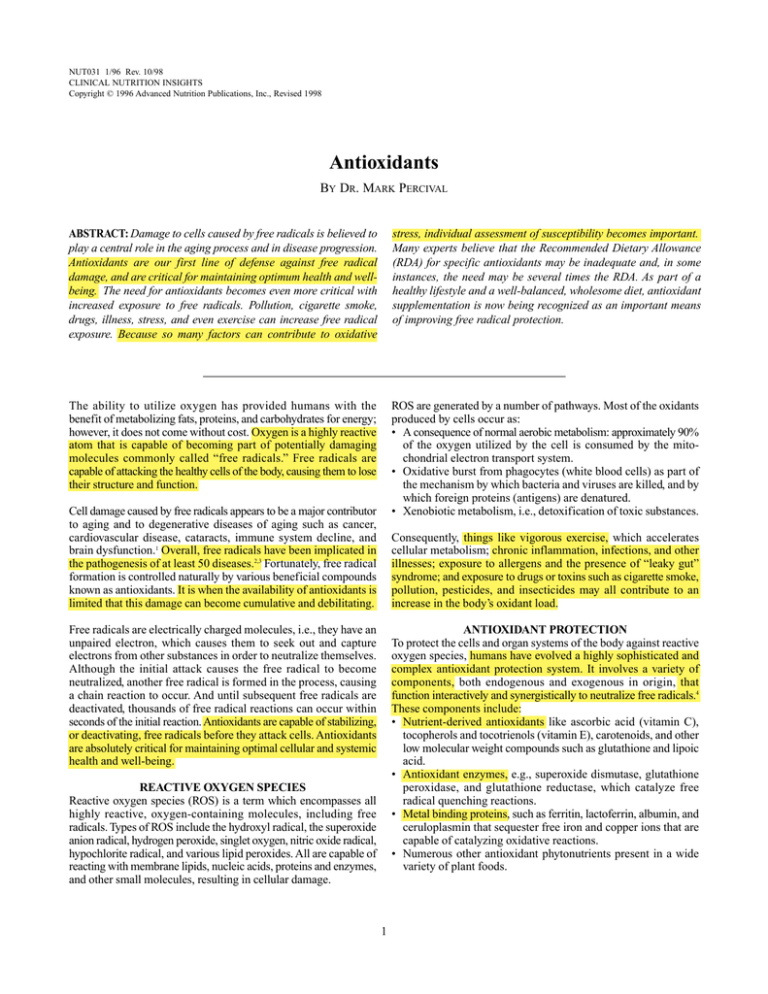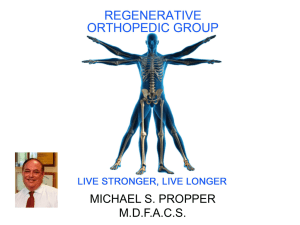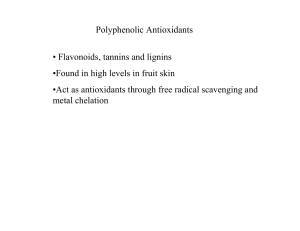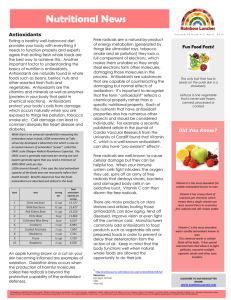Antioxidants B D . M
advertisement

NUT031 1/96 Rev. 10/98 CLINICAL NUTRITION INSIGHTS Copyright © 1996 Advanced Nutrition Publications, Inc., Revised 1998 Antioxidants BY DR. MARK PERCIVAL ABSTRACT: Damage to cells caused by free radicals is believed to play a central role in the aging process and in disease progression. Antioxidants are our first line of defense against free radical damage, and are critical for maintaining optimum health and wellbeing. The need for antioxidants becomes even more critical with increased exposure to free radicals. Pollution, cigarette smoke, drugs, illness, stress, and even exercise can increase free radical exposure. Because so many factors can contribute to oxidative stress, individual assessment of susceptibility becomes important. Many experts believe that the Recommended Dietary Allowance (RDA) for specific antioxidants may be inadequate and, in some instances, the need may be several times the RDA. As part of a healthy lifestyle and a well-balanced, wholesome diet, antioxidant supplementation is now being recognized as an important means of improving free radical protection. The ability to utilize oxygen has provided humans with the benefit of metabolizing fats, proteins, and carbohydrates for energy; however, it does not come without cost. Oxygen is a highly reactive atom that is capable of becoming part of potentially damaging molecules commonly called “free radicals.” Free radicals are capable of attacking the healthy cells of the body, causing them to lose their structure and function. ROS are generated by a number of pathways. Most of the oxidants produced by cells occur as: • A consequence of normal aerobic metabolism: approximately 90% of the oxygen utilized by the cell is consumed by the mitochondrial electron transport system. • Oxidative burst from phagocytes (white blood cells) as part of the mechanism by which bacteria and viruses are killed, and by which foreign proteins (antigens) are denatured. • Xenobiotic metabolism, i.e., detoxification of toxic substances. Cell damage caused by free radicals appears to be a major contributor to aging and to degenerative diseases of aging such as cancer, cardiovascular disease, cataracts, immune system decline, and brain dysfunction.1 Overall, free radicals have been implicated in the pathogenesis of at least 50 diseases.2,3 Fortunately, free radical formation is controlled naturally by various beneficial compounds known as antioxidants. It is when the availability of antioxidants is limited that this damage can become cumulative and debilitating. Consequently, things like vigorous exercise, which accelerates cellular metabolism; chronic inflammation, infections, and other illnesses; exposure to allergens and the presence of “leaky gut” syndrome; and exposure to drugs or toxins such as cigarette smoke, pollution, pesticides, and insecticides may all contribute to an increase in the body’s oxidant load. Free radicals are electrically charged molecules, i.e., they have an unpaired electron, which causes them to seek out and capture electrons from other substances in order to neutralize themselves. Although the initial attack causes the free radical to become neutralized, another free radical is formed in the process, causing a chain reaction to occur. And until subsequent free radicals are deactivated, thousands of free radical reactions can occur within seconds of the initial reaction. Antioxidants are capable of stabilizing, or deactivating, free radicals before they attack cells. Antioxidants are absolutely critical for maintaining optimal cellular and systemic health and well-being. ANTIOXIDANT PROTECTION To protect the cells and organ systems of the body against reactive oxygen species, humans have evolved a highly sophisticated and complex antioxidant protection system. It involves a variety of components, both endogenous and exogenous in origin, that function interactively and synergistically to neutralize free radicals.4 These components include: • Nutrient-derived antioxidants like ascorbic acid (vitamin C), tocopherols and tocotrienols (vitamin E), carotenoids, and other low molecular weight compounds such as glutathione and lipoic acid. • Antioxidant enzymes, e.g., superoxide dismutase, glutathione peroxidase, and glutathione reductase, which catalyze free radical quenching reactions. • Metal binding proteins, such as ferritin, lactoferrin, albumin, and ceruloplasmin that sequester free iron and copper ions that are capable of catalyzing oxidative reactions. • Numerous other antioxidant phytonutrients present in a wide variety of plant foods. REACTIVE OXYGEN SPECIES Reactive oxygen species (ROS) is a term which encompasses all highly reactive, oxygen-containing molecules, including free radicals. Types of ROS include the hydroxyl radical, the superoxide anion radical, hydrogen peroxide, singlet oxygen, nitric oxide radical, hypochlorite radical, and various lipid peroxides. All are capable of reacting with membrane lipids, nucleic acids, proteins and enzymes, and other small molecules, resulting in cellular damage. 1 TABLE I: VARIOUS ROS AND CORRESPONDING NEUTRALIZING ANTIOXIDANTS ROS Hydroxyl radical Superoxide radical Hydrogen peroxide Lipid peroxides catalytic activity. It has been suggested that an inadequate dietary intake of these trace minerals may compromise the effectiveness of these antioxidant defense mechanisms.11 Research indicates that consumption and absorption of these important trace minerals may decrease with aging.11 Intensive agricultural methods have also resulted in significant depletion of these valuable trace minerals in our soils and the foods grown in them. NEUTRALIZING ANTIOXIDANTS vitamin C, glutathione, flavonoids, lipoic acid vitamin C, glutathione, flavonoids, SOD vitamin C, glutathione, beta carotene, vitamin E, CoQ10, flavonoids, lipoic acid beta carotene, vitamin E, ubiquinone, flavonoids, glutathione peroxidase Glutathione, an important water-soluble antioxidant, is synthesized from the amino acids glycine, glutamate, and cysteine. Glutathione directly quenches ROS such as lipid peroxides, and also plays a major role in xenobiotic metabolism. Exposure of the liver to xenobiotic substances induces oxidative reactions through the upregulation of detoxification enzymes, i.e., cytochrome P-450 mixed-function oxidase. When an individual is exposed to high levels of xenobiotics, more glutathione is utilized for conjugation (a key step in the body’s detoxification process) making it less available to serve as an antioxidant. Research suggests that glutathione and vitamin C work interactively to quench free radicals and that they have a sparing effect upon each other.4 DIETARY ANTIOXIDANTS Vitamin C, vitamin E, and beta carotene are among the most widely studied dietary antioxidants. Vitamin C is considered the most important water-soluble antioxidant in extracellular fluids. It is capable of neutralizing ROS in the aqueous phase before lipid peroxidation is initiated. Vitamin E, a major lipid-soluble antioxidant, is the most effective chain-breaking antioxidant within the cell membrane where it protects membrane fatty acids from lipid peroxidation. Vitamin C has been cited as being capable of regenerating vitamin E.1 Lipoic acid, yet another important endogenous antioxidant, categorized as a “thiol” or “biothiol,” is a sulfur-containing molecule that is known for its involvement in the reaction that catalyzes the oxidative decarboxylation of alpha-keto acids, such as pyruvate and alphaketoglutarate, in the Krebs cycle. Lipoic acid and its reduced form, dihydrolipoic acid (DHLA), are capable of quenching free radicals in both lipid and aqueous domains and as such has been called a “universal antioxidant.”12 Lipoic acid may also exert its antioxidant effect by chelating with pro-oxidant metals. Research further suggests that lipoic acid has a sparing effect on other antioxidants.12,13 Animal studies have demonstrated supplemental lipoic acid to protect against the symptoms of vitamin E or vitamin C deficiency.12 Additional physiological antioxidants are listed in Table II. Beta carotene and other carotenoids are also believed to provide antioxidant protection to lipid-rich tissues. Research suggests beta carotene may work synergistically with vitamin E.4,5 A diet that is excessively low in fat may negatively affect beta carotene and vitamin E absorption, as well as other fat-soluble nutrients. Fruits and vegetables are major sources of vitamin C and carotenoids, while whole grains and high quality, properly extracted and protected vegetable oils are major sources of vitamin E. PHYTONUTRIENTS A number of other dietary antioxidant substances exist beyond the traditional vitamins discussed above. Many plant-derived substances, collectively termed “phytonutrients,” or “phytochemicals,” are becoming increasingly known for their antioxidant activity. Phenolic compounds such as flavonoids are ubiquitous within the plant kingdom: approximately 3,000 flavonoid substances have been described.6 In plants, flavonoids serve as protectors against a wide variety of environmental stresses while, in humans, flavonoids appear to function as “biological response modifiers.” TABLE II: ANTIOXIDANT PROTECTION SYSTEM Endogenous Antioxidants • Bilirubin • Thiols, e.g., glutathione, lipoic acid, N-acetyl cysteine • NADPH and NADH • Ubiquinone (coenzyme Q10) • Uric acid • Enzymes: – copper/zinc and manganese-dependent superoxide dismutase (SOD) – iron-dependent catalase – selenium-dependent glutathione peroxidase Flavonoids have been demonstrated to have anti-inflammatory, antiallergenic, anti-viral, anti-aging, and anti-carcinogenic activity.7-10 The broad therapeutic effects of flavonoids can be largely attributed to their antioxidant properties. In addition to an antioxidant effect, flavonoid compounds may exert protection against heart disease through the inhibition of cyclooxygenase and lipoxygenase activities in platelets and macrophages.9 Dietary Antioxidants • Vitamin C • Vitamin E • Beta carotene and other carotenoids and oxycarotenoids, e.g., lycopene and lutein • Polyphenols, e.g., flavonoids, flavones, flavonols, and proanthocyanidins The best way to ensure an adequate intake of phytonutrients is to eat a diet rich in a wide variety of fresh fruits and vegetables. Phytonutrient supplements are also now widely available. Metal Binding Proteins • Albumin (copper) • Ceruloplasmin (copper) • Metallothionein (copper) • Ferritin (iron) • Myoglobin (iron) • Transferrin (iron) ENDOGENOUS ANTIOXIDANTS In addition to dietary antioxidants, the body relies on several endogenous defense mechanisms to help protect against free radical-induced cell damage. The antioxidant enzymes – glutathione peroxidase, catalase, and superoxide dismutase (SOD) – metabolize oxidative toxic intermediates and require micronutrient cofactors such as selenium, iron, copper, zinc, and manganese for optimum 2 • Cancer Cancer is the second leading cause of death in the United States. It is estimated that diet may account for as much as 35% of all human cancers.21 Epidemiological evidence consistently relates low antioxidant intake or low blood levels of antioxidants with increased cancer risk.16 In fact, low dietary intake of fruits and vegetables doubles the risk of most types of cancers.22 OXIDATIVE STRESS As remarkable as our antioxidant defense system is, it may not always be adequate. The term “oxidative stress” has been coined to represent a shift towards the pro-oxidants in the pro-oxidant/antioxidant balance that can occur as a result of an increase in oxidative metabolism. Increased oxidative stress at the cellular level can come about as a consequence of many factors, including exposure to alcohol, medications, trauma, cold, infections, poor diet, toxins, radiation, or strenuous physical activity. Protection against all of these processes is dependent upon the adequacy of various antioxidant substances that are derived either directly or indirectly from the diet. Consequently, an inadequate intake of antioxidant nutrients may compromise antioxidant potential, thus compounding overall oxidative stress. Oxidants are capable of stimulating cell division, which is a critical factor in mutagenesis. When a cell with a damaged DNA strand divides, cell metabolism and duplication becomes deranged. Thus, a mutation can arise which in turn is an important factor in carcinogenesis. It is believed that antioxidants exert their protective effect by decreasing oxidative damage to DNA and by decreasing abnormal increases in cell division. Both cigarette smoking and chronic inflammation–two of the major causes of cancer–have strong free radical components in their mechanisms of action. Some research has indicated that people who smoke tend to have lower antioxidant levels than nonsmokers and are at an increased risk for both cancer and cardiovascular disease. Well over 100 studies have reported that reduction in cancer risk is associated with a diet high in vitamin C.23 OXIDATIVE STRESS AND HUMAN DISEASE Oxidative damage to DNA, proteins, and other macromolecules has been implicated in the pathogenesis of a wide variety of diseases, most notably heart disease and cancer.14 A growing body of animal and epidemiological studies as well as clinical intervention trials suggest that antioxidants may play a pivotal role in preventing or slowing the progression of both heart disease and some forms of cancer.15,16 TABLE III: CONDITIONS ASSOCIATED WITH OXIDATIVE DAMAGE • Atherosclerosis • Multiple sclerosis • Cancer • Pancreatitis • Pulmonary dysfunction • Inflammatory bowel disease and colitis • Cataracts • Parkinson’s disease • Arthritis and inflammatory diseases • Neonatal lipoprotein oxidation • Diabetes • Drug reactions • Shock, trauma, and ischemia • Skin lesions As mentioned earlier, the amount of fruits and vegetables included in the diet appears to have a significant impact on cancer risk. Although antioxidant activity is believed to be responsible for much of the protection against tumorgenesis, additional anticancer activities have been observed from several plant-derived substances.24 Sulfurcontaining phytochemicals, such as the allyl sulfides found in the allium family (garlic, onions, and leeks), and isothyocyanates and sulphoraphane (cabbage, broccoli, and cauliflower) have been shown to inhibit various steps in tumor development in animal and in vitro studies.24 Indoles, also found in cruciferous vegetables, and terpenes, natural constituents of citrus oils, may also be protective. • Pulmonary Disorders Because of its large surface area, the respiratory tract is a major target for free radical insult, not to mention the fact that air pollution is a major source of ROS.25,26 Recent studies suggest that free radicals may be involved in the development of pulmonary disorders such as asthma.27 Cellular damage caused by free radicals is thought to be partly responsible for the bronchial inflammation characteristic of this disease. It has been suggested that increasing antioxidant intake may help to reduce oxidant stress and help to prevent or minimize the development of asthmatic symptoms. 27 Vitamin C, vitamin E, and beta carotene supplementation has been associated with improved pulmonary function.28,29 Some evidence suggests glutathione, or possibly N-acetyl cysteine, which is a precursor to glutathione, may be helpful in protecting against pulmonary damage as well.26 • Aging • Renal disease and hemodialysis • Heart Disease Heart disease is the leading cause of death in the United States. It is estimated that one in three Americans will eventually die from this disease.15 While several factors, such as high cholesterol levels, hypertension, cigarette smoking, and diabetes, are believed to promote atherosclerosis, a growing body of evidence suggests a critical step in its development is the oxidation of low-density lipoprotein (LDL) within the arterial wall.17 This theory is supported by several epidemiological studies which link low intakes of dietary antioxidants to an increased frequency of heart disease.15 Additionally, an inverse relationship between heart disease and plasma antioxidant levels has been reported.18 Other major pathologies that may involve free radicals include neurological disorders and cataracts.25 Neural tissue may be particularly susceptible to oxidative damage because it receives a disproportionately large percentage of oxygen and it has a high concentration of polyunsaturated fatty acids which are highly prone to oxidation.30 Formation of cataracts is believed to involve damage to lens protein by free radicals, causing the lens to lose its transparency. Some evidence suggests that cataract progression might be slowed with regular consumption of supplemental antioxidants, in particular vitamin E, vitamin C, and the carotenoids.31 It is estimated that if cataract development were delayed by 10 years as a result of increased antioxidant protection, the number of cataract surgeries performed in the U.S. would decrease by more than half.32 Antioxidants have been shown to prevent LDL oxidation in vitro and retard the progression of atherosclerosis in animal models.19 Several human studies found supplemental vitamin E increased vitamin E levels in LDL, increased the resistance of LDL oxidation, and decreased the rate of LDL oxidation.15 In a recent retrospective study, Stampfer, et al. found that nurses who consumed higher amounts of vitamin E on a regular basis had a 41% lower incidence of heart disease than nurses who consumed the lowest level of vitamin E from their diet and supplements.20 It has been estimated that dietary increases in antioxidant vitamins may reduce the risk of heart disease by 20-30%.15 3 THE MITOCHONDRIA AND OXIDATIVE STRESS The mitochondria are the energy power houses of the cell. Due to their critical role in producing the energy that drives every physiologic process, mitochondrial function is an area of intense interest and study today. It has been suggested that certain chronic illnesses related to muscle pain and chronic fatigue, e.g., myofascial pain syndrome (MPS), fibromyalgia syndrome, and chronic fatigue immunodeficiency syndrome (CFIDS), are disorders in which there is an aberration or dysfunction of mitochondrial energy production.34, 36 It has been suggested that mitochondrial dysfunction is related to damage caused by ROS produced as a consequence of increased oxidative stress and insufficient antioxidant defenses.35 Levels of ROS produced within the mitochondria are reported to increase with age. Consequently, oxidative damage to mitochondria would also appear to increase with age. This damage results in a decrease in energy production by some of the cell’s mitochondria. single one of the antioxidants vitamin C, vitamin E, or beta carotene, appears to increase the risk of cardiovascular disease. Additionally, the combination of several suboptimal concentrations may have an additive or even synergistic affect on increasing risk. Conversely, it has been suggested that, under certain conditions, an excess of any one type of antioxidant in the absence of balance with the others may actually be counter-protective.26 Moreover, the relative importance of a given antioxidant may vary with different disease conditions because the type or types of ROS generated are likely to differ, and because varying levels of specific antioxidants exist within the different tissues of the body. NITRIC OXIDE: A NEW REGULATOR OF OXIDATIVE STRESS? Nitric oxide (NO), discovered to be produced by mammalian cells only in the past decade, is a regulatory molecule that has come under increasing interest and scrutiny due to its role as an important mediator of homeostatic processes and immunity.26 NO is believed to participate in the regulation of the oxidation/reduction potential of various cells and may be involved in “either the protection against or the induction of oxidative stress within various tissues, depending upon its concentration.”26 Emerging evidence suggests that some diseases are related to either an inadequate or excessive production of NO.38 Furthermore, changes in the concentration of arginine, an amino acid from which NO is formed, may influence NO generation and activity.38 Several animal and human studies indicate a role for arginine in improving immune response and wound healing, presumably the result of increased NO activity.39 On the other hand, an inappropriately high concentration of NO has been implicated in several diseases and disorders. Other nutrients that may have an impact on NO generation and activity include riboflavin, niacin, folate, folic acid, vitamin B12, omega-3 essential fatty acids, and various antioxidants.40 Mitochondrial function is supported by a broad spectrum of nutritional modulators including antioxidants and antioxidant support systems. Two important modulators that appear to clinically benefit mitochondrial function are N-acetyl carnitine, which assists fatty acid transport into the mitochondria, and N-acetyl cysteine, which stimulates mitochondrial glutathione synthesis and acts as an antioxidant. THE IMPORTANCE OF BALANCE Although much of the research to date focuses on the potential benefit of single antioxidant nutrients, it has become clear that the best protection against oxidative stress comes from a wide assortment of interrelated antioxidants and antioxidant cofactors.4 In other words, the human body utilizes an integrated antioxidant system composed of several players that work together as a team. The reducing potential of each individual member of the antioxidant defense team is enhanced when a full complement of players is available. For example, some evidence suggests a poor concentration of any REFERENCES 1. 2. 3. 4. 5. 6. 7. 8. 9. 10. 11. 12. 13. 14. 15. 16. 17. 18. 19. 20. Sies, H. et al., Antioxidant Function of Vitamins. Ann NY Acad Sci 1992;669:7-20. Langseth, L. From the Editor: Antioxidants and Diseases of the Brain. Antioxidant Vitamins Newsletter 1993;4:3. Halliwell, B., Free Radicals, Antioxidants, and Human Disease: Curiosity, Cause, or Consequence? Lancet 1994;344:721-724. Jacob, R.A., The Integrated Antioxidant System. Nutr Res 1995;15(5):755-766. Sies, H. and Stahl, W., Vitamins E and C, beta carotene, and other carotenoids as antioxidants. Am J Clin Nutr 1995;62(suppl):1315S-21S. Briviba, K. and Sies, H., Nonenzymatic Antioxidant Defense Systems Ch 4, p. 107-128. In: Natural Antioxidants in Human Health and Disease. ed. Frei, B. Academic Press: San Diego, 1994. Cody, V., Middleton, E. and Harborne, J.B., Plant Flavonoids in Biology and Medicine-Biochemical, Pharmacological, and Structure-activity Relationships, Alan R. Liss, New York, NY, 1986. Kuhnau, J., “The flavonoids: a class of semi-essential food components: their role in human nutrition,” Wld Rev. Nutr. Diet, 1976, 24, pp. 117-91. Havsteen, B. flavonoids, a Class of Natural Products of High Pharmacological Potency. Biochem Pharm 1983;32(7):1141-1148. Middleton, E., “The flavonoids,” Trends in Pharmaceut. Sci., 1984, 5, pp. 335-8. Duthie, G.G., and Brown, K.M., Reducing the Risk of Cardiovascular Disease, ch 2, p. 19-38, In: Functional Foods, ed. Goldberg, I. Chapman and Hall: New York 1994. Packer, L. and Witt, E.H., Antioxidant Properties and Clinical Implications of Alpha-Lipoic Acid. in Packer L. and Cadenas E. eds. Biothionls in Health and Disease. New York: Marcel Dekker, Inc, 1995, 479-516. Kagen, V.E., et al., Dihydrolipoic Acid–a Universal Antioxidant Both in the Membrane and in the Aqueous Phase. Biochem Pharmacol 199244:1637-1649. Halliwell, B. Free Radicals, Antioxidants, and Human Disease: Curiosity, Cause, or Consequence? Lancet 1994;344:721-724. Hennekens, C.H. and Gaziano, J.M., Antioxidants and Heart Disease: Epidemiology and Clinical Evidence. Clin Cardiol 1993;16(suppl I):I-10, I-15). Block, G. et al. Fruit, Vegetables, and Cancer Prevention: A Review of the Epidemiological Evidence, Nutr Cancer 1992;18(1):1-29. Jialal, I. and Fuller, C.J., Oxidized LDL and Antioxidants. Clin Cardiol 1993;16(suppl I):I-6-I-9. Gey, K.F., et al., Plasma Levels of antioxidant Vitamins in Relation to Ischemic Heart Disease and Cancer. Am J Clin Nutr 1987;32:511-512. Keaney, JF., Jr. , and Frei, B., Antioxidant Protection of Low Density Lipoprotein and Its Role in the Prevention of Atherosclerotic Vascular Disease. ch.11 p. 303-351. Stampfer, M.J. et al., Vitamin E Consumption and the Risk of Coronary Disease in Women. N Eng J Med 1993;328:1444-1449. 21. Hennekens, C.H., Antioxidant Vitamins and Cancer. Am J Med 1994;97(SA)2S-4S; discussion 22S-28S. 22. Ames, B. Forward p. xix-xxv, in Natural Antioxidants in Human Health and Disease, ed. Frei, B. Academic Press: San Diego 1994. 23. Fontham, E.T., Vitamin C, Vitamin C-Rich Foods, and Cancer: Epidemiologic Studies. ch 6, p 157-197. 24. Milner, J.A., Reducing the Risk of Cancer. ch 3, p 39-70. in Functional Foods ed. Goldberg, I. Chapman and Hall: New York 1994. 25. Kehrer, J.P. and Smith, C.V., Free Radicals in Biology: Sources, Reactivities, and Roles in the Etiology of Human Diseases. ch 2, p25-62, In: Natural Antioxidants in Human Health and Disease. ed. Frei, B. Academic Press: San Diego, 1994. 26. Bland, J. S., Oxidants and Antioxidants in Clinical Medicine: Past, Present, and Future Potential. J Nutr Environ Med 1995;5:255-280. 27. Greene, L.S., Asthma and Oxidant Stress: Nutritional, Environmental, and Genetic Risk Factors. J Am Coll Nutr 1995;14(4):317-324. 28. Hatch, G.E., Asthma, Inhaled Oxidants, and Dietary Antioxidants. Am J Clin Nutr 1995;61 (3 suppl):625S-630S) 29. Bendich, A., Role of Antioxidants in the Maintenance of Immune Functions, ch. 15, p. 447-467. in Natural Antioxidants in Human Health and Disease. ed. Frei, B. Academic Press: San Diego, 1994. 30. Muller, D.P., Vitamin E and Other Antioxidants in Neurological Function and Disease, ch. 19, p. 535-565. in Natural Antioxidants in Human Health and Disease. ed. Frei, B. Academic Press: San Diego, 1994. 31. Jacques, P.F., et al. Cataracts, Neurological Disorders, and Exercise. ch. 18, 515-533. in Natural Antioxidants in Human Health and Disease. ed. Frei, B. Academic Press: San Diego, 1994. 32. Taylor, A., Cataract: Relationships Between Nutrition and Oxidation. J Am Coll Nutr 1993;12(2):138-146. 33. Maitra, I. et al., Alpha-Lipoic Acid Prevents Buthionine Sulfoximine-Induced Cataract Formation in Newborn Rats. Free Rad Biol Med 1995;18:823-829. 34. Trounce, I. et al., Decline in Skeletal Muscle Mitochondrial Respiratory Chain Function: Possible Factor in Aging. Lancet. 1989;I(8639):637-638. 35. Shigenaga, M.K. and Ames, B.N., Oxidants and Mitochondrial Decay in Aging. Ch 3, p 63-106. in Natural Antioxidants in Human Health and Disease. ed. Frei, B. Academic Press: San Diego, 1994. 36. Eisinger, J. et al., Glycolysis abnormalities in Fibromyalgia. J Am Col Nutr. 1994;13(2):144-148. 37. Ames, B. Ames Agrees with Mom’s Advice: Eat Your Fruits and Vegetables. JAMA 1995;272(14):1077-1078. 38. Moncada, S. and Higgs, A., The L-Arginine-Nitric Oxide Pathway. N Eng J Med 1993;329(27):2002-2012. 39. Alford, B., Liepa, G., VanBeber, A.D., Arginine: The Neglected Amino Acid? Inform 1994;5(11):1276-1278. 40. Hoffman, M., A New Role for Gases: Neurotransmission. Science. 1991;252:1788. 4




